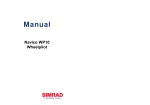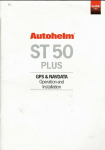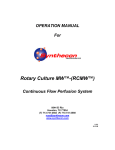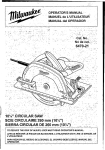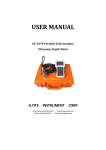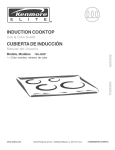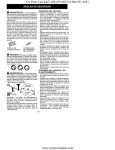Download Raymarine ST30 Product specifications
Transcript
Distributed by Any reference to Raytheon or RTN in this manual should be interpreted as Raymarine. The names Raytheon and RTN are owned by the Raytheon Company. TOP EDGE BLEED MASK FOR 2 COLOUR SEATALK LOGO ST 30 DEPTH Operation and Installation TOP EDGE BLEED MASK FOR 2 COLOUR SEATALK LOGO Nautech Limited, Anchorage Park, Portsmouth P03 5TD, England Telephone (0705) 693611. Fax (0705) 694642 ST30 Depth Operation and Installation Handbook s tre Me W LO AL SH EP DE UM IM MIN ET FS OF PL DIS AY H PT DE TM Autohelm and SeaTalk are registered Trade Marks of Nautech Limited Autohelms policy of continuous improvement and updating may change product specifications without prior notice Copyright Nautech 1992 ST30 Depth Operation and Installation Handbook Package Contents The following items are included in the ST30 Depth package: 1. ST30 Depth instrument 2. Fixing studs (2 off) 3. Thumb nuts (2 off) 4. Fitting template 5. 1m power cable 6. Depth transducer (through hull) with 10m cable and 1/8in spade connectors 7. Instrument cover 8. Operation and installation handbook 9. Daisy-chain cable 1 2 3 SHALLOW DEEP MINIMUM OFFSET 6 DISPLAY DEPTH TM ST30 INSTRUMENT MOUNTING TEMPLATE 7 TM 4 2-HOLES DRILL 5mm ( .197in ) DIA SeaTalk 1-HOLE DRILL 60.3mm ( 2,3/8in ) DIA SeaTalk TM ST30 5 8 9 DEPTH Operation and Installation SeaTalk SeaTalk D624 ST30 Depth Operation and Installation Handbook 3 Contents Introduction ....................................................................... 4 Chapter 1: Control Head Installation ................................... 5 1.1 Siting ............................................................................. 5 1.2 Mounting procedure ........................................................ 6 1.3 Power supply (Stand-alone operation) ............................... 7 1.4 Power supply (SeaTalk system) ........................................ 7 1.5 Connection to adjacent ST30 Instruments ......................... 8 Chapter 2: Transducer Installation ...................................... 9 2.1 Connection to instrument ................................................. 9 2.2 Transducer type ............................................................. 9 2.3 Installation .................................................................... 10 Chapter 3: Fault Finding ................................................... 12 Chapter 4: Maintenance ................................................... 13 4.1 Instrument .................................................................... 13 4.2 Transducer ................................................................... 13 4.3 Cabling ........................................................................ 13 4.4 Advice .......................................................................... 13 Chapter 5: Operation ....................................................... 14 5.1 Display Key .................................................................. 14 5.2 Light Key ...................................................................... 16 5.3 Alarms ......................................................................... 16 Loss of signal ............................................................... 16 Chapter 6: Calibration ..................................................... 17 6.1 Entry to calibration ........................................................ 17 6.2 Depth units selection ..................................................... 17 6.3 Alarms and Offset ......................................................... 18 Shallow alarm ............................................................... 18 Deep alarm .................................................................. 19 Offset .......................................................................... 20 Exit calibration .............................................................. 21 6.4 Calibration Lock/Unlock ................................................ 22 Return to normal display mode ...................................... 23 6.5 Master/Repeater display ............................................... 23 Return to normal display mode ...................................... 25 Chapter 7: General Specification ...................................... 26 ST30 Depth Operation and Installation Handbook 4 Introduction Designed for above or below deck installation, the ST30 Depth can be used as a stand-alone master instrument or be set up to repeat information from the SeaTalk bus. The ST30 Depth will display the following information: • Water depth • Shallow alarm • Deep alarm • Keel/Waterline offset • Minimum depth • Illumination level s tre Me L AL SH OW EP DE UM IM MIN ET FS OF Y LA SP DI H PT DE TM D625 5 Chapter 1: Control Head Installation Chapter 1: Control Head Installation 42mm (1.65in) 110mm (4.33in) 56mm (2.20in) SHALLOW DEEP MINIMUM OFFSET DISPLAY Autohelm 88mm (3.46in) 24mm (1.0in) DEPTH D626 1.1 Siting The ST30 Depth instrument may be installed above or below deck where it is: • easily readable by the helmsman (normally viewed at eye level) • protected from physical damage • at least 230mm (9in) from a compass • at least 500mm (20in) from radio receiving equipment • accessible from behind for ease of installation and cable running Note: To prevent the build-up of moisture the instrument breathes through the back cover. The instrument must, therefore, be mounted where the back cover is protected from direct water. The case is fitted with a foam gasket to form a water tight seal between the instrument and the installation face. ST30 Depth Operation and Installation Handbook 6 1.2 Mounting procedure 3 6 5 2 4 1 D627 1 Instrument 2 Fixing studs 3 Thumb nuts 4 Sealing gasket 5 Power supply cable 6 Transducer cable 1. Make sure the surface to which the instrument (1) is to be mounted is smooth and flat. 2. Use the template (supplied) to mark the centres for the fixing studs (2) and the instrument connector boss. Note: To allow protective covers to be fitted, adjacent instruments should be sited not less than 6mm (0.24in) from each other (116mm centre to centre min.). 3. Drill two 5mm (0.2in) diameter holes for the fixing studs (2). 4. Using a 60mm (2 3/8in) diameter cutter, drill a location hole for the instrument connector boss. 5. Connect the power supply and transducer cables to the back of the instrument (1). (See relevant installation sections) 6. Screw the two fixing studs (2) into the back cover of the instrument (1). 7. Install the instrument (1) and secure with the thumb nuts (3) provided. 7 Chapter 1: Control Head Installation 1.3 Power supply (Stand-alone operation) Caution: The ST30 Depth must only be connected to a 12V supply. + + SEATALK DE PT H + + 5A + Red 12V Supply Screen – D627a For stand-alone operation, use the 1m cable supplied with the instrument. 1. Connect the moulded power plug to either SeaTalk connection on the rear of the instrument. Run the free end back to the vesselÕs distribution panel. 2. Cut the power cable to length and connect the red wire to the positive 12V terminal and the screen to 0V. Protect with a 5A circuit breaker or fuse. 1.4 Power supply (SeaTalk system) If the ST30 Depth is to be connected to a SeaTalk system, use a Standard SeaTalk Extension or Interface cable. Autohelm Autohelm Autohelm Power Extension Cable D628 8 ST30 Depth Operation and Installation Handbook 1.5 Connection to adjacent ST30 instruments The ST30 Depth is supplied with a daisy-chain cable that allows adjacent ST30 instruments to be linked together. The daisy-chain cable supplies power to adjacent instruments and allows data to be transmitted and received via the SeaTalk bus. The daisy-chain cable plugs into one of the SeaTalk ports on the back cover. Incorrect orientation is not possible as the ports and plugs are matched. 9 Chapter 2: Transducer Installation Chapter 2: Transducer Installation 2.1 Connection to instrument The ST30 Depth transducer is supplied with 10m (32.5ft) of cable. This cable plugs directly into the back of the instrument. + + SEATALK DE PT H + + D629 2.2 Transducer type The ST30 Depth system is supplied (as standard) with a plastic through hull transducer. This is suitable for use with Glass Reinforced Plastic (GRP), Steel and Aluminium hulls. Wooden hull and transom mount installations require a different type of transducer. Please refer to the following table for details. Hull material or location Transducer GRP, Steel, Aluminium Standard through hull plastic Wood Bronze through hull (Z118) GRP, Steel, Aluminium Retractable through hull (Z120) In hull In hull puck (Z117) Caution: Plastic through hull transducers must not be used on vessels with wooden hulls. ST30 Depth Operation and Installation Handbook 10 2.3 Installation All depth transducers are supplied with detailed installation and maintenance instructions. These instructions, together with the following notes, should be read thoroughly before attempting to install the transducer. 10° Max D630 1. The ST30 Depth transducer must be within 10° of the vertical, forward, aft and athwart ships and within the shaded clear flow areas as shown. D587 11 Chapter 2: Transducer Installation 2. Run the transducer cable back to the instrument. Avoid fluorescent lights, engines, radio transmitting equipment and the speed transducer cable. The transducer cable should also be kept clear of bilge's, where possible, and be secured at regular intervals. Note: The transducer cable must not be shortened. Shortening of this cable will affect the performance of the unit. For further information, please contact Autohelm or an authorised agent. If the bronze through hull (Z118), in hull puck (Z117) or retractable depth (Z120) transducers are to be used, the following modification must be carried out to the transducer lead. 1. Using a pair of wire cutters, remove the moulded plug from the end of cable. 2. Strip the outer cable back 38mm (1.5in). 3. Using a pair of cable strippers, remove 10mm (3/8in) of insulation from each wire. 4. Using a suitable crimping tool, attach a 1/8in spade connector (supplied) to each of the wires. 5. Connect the wires to the instrument in accordance with the following table. Transducer type Colour coding (cable to unit) Bronze through hull (Z118) Blue Ð red terminal Black and screen Ð white terminal In-hull puck (Z117) As above Retractable depth (Z120) As above ST30 Depth Operation and Installation Handbook 12 Chapter 3: Fault Finding All Autohelm products are, prior to packing and shipping, subject to comprehensive test and quality assurance programmes. However, if a fault arises with the ST30 Depth, the following table will help to identify the probable cause and provide the most likely cure. Fault Cause Action Instrument display blank No supply to instrument Check supply Check cabling and security of connectors Check circuit breaker/fuse Return ST30 Depth for repair No depth information Aereated water, boat wakes or propeller wash Depth reading will return to normal once clear of disturbed water Feet/metres display flashes continuously Transducer cable or connector fault Check cabling and security of transducer connector No exchange of information between SeaTalk instruments SeaTalk cabling or connector problem Check security of SeaTalk connectors Remove instruments one by one to isolate faulty unit Failure of a group of Cabling or connector instruments in a chain problem Check the security of the connectors between functioning and non-functioning instruments Unable to enter calibration Refer to Calibration lock/ unlock section Calibration locked Note: After installation, poor performance may be experienced if the surface of the depth transducer has not been 'wetted'. Wetting can take up to 24 hours under normal conditions. The transducer can be 'wetted' prior to launch by applying a mild detergent to the external face. 13 Chapter 4: Maintenance Chapter 4: Maintenance 4.1 Instrument Atmospheric conditions may cause condensation to appear on the instrument window. This will not harm the instrument and can be cleared by increasing the illumination setting to level 3. Chemical and abrasive materials must not be used to clean the ST30 Depth instrument; if the instrument is dirty, clean with a soft, damp cloth. 4.2 Transducer Refer to the Installation and Maintenance instructions supplied with the transducer. 4.3 Cabling Examine all cables for chafing or damage to the outer shield and, where necessary, replace and re-secure. 4.4 Advice For advice, or further information regarding installation of this product, please contact the Autohelm Product Support Department or your own National Distributor. ST30 Depth Operation and Installation Handbook 14 Chapter 5: Operation The ST30 Depth leaves the factory set to: • display depth in feet • with the deep and shallow alarms switched off • in master mode These settings can be changed in calibration (see section 6.1). When the ST30 Depth is switched on, the instrument will display current water depth in the units set up in calibration. SHALLOW Feet DEEP MINIMUM D643 OFFSET Note: The trend arrows ▲ decreasing ▼ increasing, shown in the above display, indicate whether the trend is towards deep or shallow water. 5.1 Display Key Each press of Display cycles the following menu: • Shallow Alarm Setting • Deep Alarm Setting • Minimum Depth • Offset (Keel or Waterline) A further press of Display will return the unit to current depth. The display always returns to current depth after 8 seconds. SHALLOW Feet DEEP MINIMUM OFFSET TM DEPTH D644 DISPLAY 15 Chapter 5: Operation SHALLOW Feet DEEP MINIMUM OFFSET DEPTH SHALLOW D645 DISPLAY Feet DEEP MINIMUM OFFSET DEPTH TM D646 DISPLAY Note: The 'Minimum' depth display may be reset by pressing second. SHALLOW Feet DEEP MINIMUM OFFSET D647 DISPLAY TM DEPTH for 1 ST30 Depth Operation and Installation Handbook 16 5.2 Light Key Controls the level of instrument illumination. There are 3 levels, with level 3 the brightest. SHALLOW DEEP MINIMUM OFFSET TM DEPTH D648 DISPLAY The display returns to correct depth after 8 seconds. Note: When the ST30 Depth is used in a SeaTalk system, illumination may be adjusted from any instrument. 5.3 Alarms The ST30 Depth is equipped with visual and audible shallow and deep water alarms. Both of these alarms are set in calibration (see section 6.3). Any button press will silence the 'Shallow' alarm. However, the 'Shallow' indicator will continue to flash until the depth exceeds the alarm value. The 'Deep' alarm sounds when the 'Deep' setting is crossed either when going from shallow to deep or deep to shallow waters. Any button press will silence the alarm. Loss of Signal The 'feet or metres' legend flashes whenever the depth signal is lost. SHALLOW DEEP Metres MINIMUM D657 OFFSET Chapter 6: Calibralicn Chapter 6: Calibration 6.1 Entry to calibration The ST30 Depth can be programmed to display depth information in feet or metres. To enter calibration, press and hold Diiy and %f After 2 seconds the display till show CM. Each press of Display will cycle the unitthrough the calibration menu. 6.2 Depth units selection 1. Cycle Display until the display shows feet or meties. 2. Select feet or metres as required using A. 6.3 Alarms and Offset Shallow alarm 1. Cycle Display until the ‘Shallod alarm is displayed. 2. Press A or V to set the required depth. fr 3. 17 Shallow Alarm is enabled by pressing %T When the alarm is on the ‘Alarm’ legend will be displayed. Chapter 6: Calibration 19 ;: ,: iiiii,ii,,i,,,ii,ii, ,,i, ,,i , , ,.i, , , , ,i,, ,i,,,, ,i,,, iiii Deep alarm 1. Cycle Display until ‘Deep’ alarm is displayed. 2. Press A or V to set the required depth - i 3. DEPTI The ‘Deep’ alarm is enabled by pressing 9. When the alarm is on the ‘Alarm’ legend will be displayed. I - DEPTH ST30 Depth Operation and hstallalion Handbook 20 Offset The instrument measures the water depth below the transducer. To display water depth below the keel or to the surface an offset must be set up. A negative offset is used to reduce the displayed value and give depth below the keel, a positive offset will give water depth to the surface. 1. Press Display until 2. offd is selected. DEPTH Press A or V until the rewired offset is I I - I 1 DEPTH Exii calibration To exii calibration and return to depth mode, press and hdd Display and for a 2 seconds. 111111 DEPTH 6.4 Calibration Lock/Unlock The lock/unlock feature removes the risk of accidentaliy changing the set calibration values. For securii, the calibrabon lock/unlock feature is accessed by an extended hold down of the 4 and Dfspfay keys as follows: 1. Press and hold Diiplay and %T for 14 seconds until CAL is displayed for tie second time. 2. Press A and V momentarily. f, I 23 -6:C 3. Calibrabon lock/unlock is switched on or off usin&? A CO = Calibration locked i.e. no access Cl = Calibration unlocked i.e. normal access. Return to normal display mode Press and hold Display and a After 2 seconds the display returns to depth mode. 6.5 Master/Repeater display As It leaves the factory the ST30 Dapth is set to operate in Master mode. In this mode the inshument is connected to a depm transducer and bansmits depth informah onto the SeaTalk bus. The ST30 Depth can be set as a Repeater, repeating depth infomutitx already on the SeaTalk bus. Repeater mode is set as follows: STSODephOperaWnmdlnstal&limrtaRationHandbook 1 . PressandholdDispbyand~uuntilthedisplayshowsaUandatwa figure number. 2. Press Display to show the current operating mode. 3. Press A to change mode. r0 = Master mode rl = Repeater mode Note: When the ST30 Depi31 is set in Repeater mode access to Calibration is inhibited. Chapter6:Calibra6on 25 Return to normal display mode Press and hold Display and ?# After 2 seconds UE display returns to depth mode. ST30 Depth Operation and Installation Handbook 26 Chapter 7: General Specification Power supply: Power consumption: 10 to 16V 60mA (without illumination) 100mA (illuminated) Transmitted power (RMS): 50W Operating frequency: 200kHz Temperature range: 0 to 70 deg° C Shallow alarm: 1 to 10m (0.1 increments) 3 to 33ft (1ft increments) Deep alarm: 3 to 120m (1m increments) 10 to 400ft (10ft increments) Offset: –4 to +4m (0.1 increments) –9.9 to +9.9ft (0.1 increments) Minimum depth function: Reset on power-up Units: Software programmable selection in metres (m) or feet (ft) – stored in EPROM Calibration lock/unlock: Software programmable Repeater capability: Software programmable 81002-1 TOP EDGE BLEED MASK FOR 2 COLOUR SEATALK LOGO Nautech Limited, Anchorage Park, Portsmouth P03 5TD, England Telephone (0705) 693611. Fax (0705) 694642 TOP EDGE BLEED MASK FOR 2 COLOUR SEATALK LOGO Nautech Limited, Anchorage Park, Portsmouth P03 5TD, England Telephone (0705) 693611. Fax (0705) 694642

































